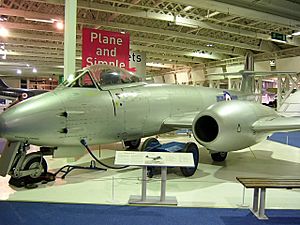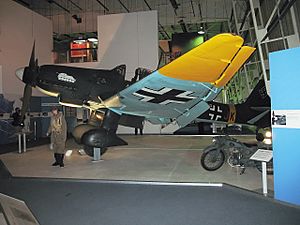Royal Air Force Museum London facts for kids
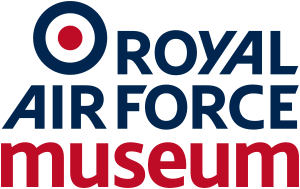 |
|
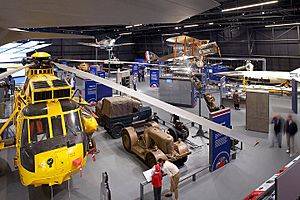 |
|
| Lua error in Module:Location_map at line 420: attempt to index field 'wikibase' (a nil value). | |
| Former name | Royal Air Force Museum, Hendon |
|---|---|
| Established | 15 November 1972 |
| Location | Grahame Park Way, Colindale London, NW9 5LL United Kingdom |
| Type | Aviation museum |
| Visitors | 440,338 (2024) |
| Public transit access | |
The Royal Air Force Museum London, often called the RAF Museum, is a cool place to visit in North London! It's built on what used to be Hendon Aerodrome, a famous old airfield. This museum has five buildings and hangars. They show the amazing story of aviation and the Royal Air Force (RAF). It's part of the larger Royal Air Force Museum group.
There is also another RAF Museum site. It is located at Royal Air Force Museum Midlands near RAF Cosford in Shropshire.
History of the RAF Museum
From Airfield to Museum Site
The museum in Colindale is on land that was once part of RAF Hendon. Before that, it was one of the first civilian airfields. A man named Claude Grahame-White bought it in 1911.
In 1914, during the First World War, the airfield was taken over by the military. It became a Royal Naval Air Station. Here, new pilots learned how to fly. After the war ended, the flying stopped.
From 1927 to 1939, Hendon was home to No. 601 Squadron RAF. This group was nicknamed the 'Millionaires' Squadron'. This was because many of its volunteer pilots were very wealthy.
Hendon During World War II
When World War II started in 1939, Hendon became an active RAF station again. It was home to No. 24 Squadron RAF, which handled transport and communications. Hendon also briefly served as a fighter base during the Battle of Britain.
The very last flight by a regular airplane at Hendon happened on June 19, 1968. A Blackburn Beverley aircraft landed there. It was delivered to the museum before its official opening. Soon after, the runways were removed to build the Grahame Park housing estate. RAF Hendon officially closed on April 1, 1987.
The Museum Opens and Grows
The Royal Air Force Museum was officially opened. This happened at the Colindale site on November 15, 1972. Queen Elizabeth II herself opened it! When it first opened, the hangars held 36 aircraft.
Over the years, the museum's collection has grown a lot. Airplanes not shown at Hendon were kept or displayed at smaller RAF station museums.
The first director of the museum was Dr. John Tanner. He retired in 1987. Later, Maggie Appleton became the CEO of the museum in October 2014.
The Battle of Britain Museum opened in November 1978. Queen Elizabeth The Queen Mother opened it. This hall was later updated and reopened.
The London museum site has been regularly expanded. For example, the area around the museum has been landscaped. This helps show what the old Hendon airfield looked like.
Amazing Aircraft on Display
As of 2012, the museum had over 100 aircraft. One famous plane is the Avro Lancaster S-Sugar. This bomber flew 137 night missions during the war! The museum also has the only complete Hawker Typhoon aircraft.
In 2018, new aircraft were added for the RAF's 100th birthday. These included a Westland Sea King helicopter. This type of helicopter was once flown by Prince William, Duke of Cambridge. There's also a Gnat jet trainer from the Red Arrows display team. You can also see a full-size model of the F-35 Lightning II stealth fighter.
What You Can See at the Museum
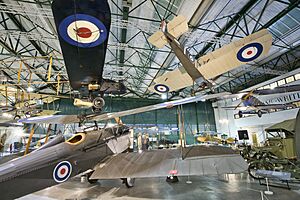
The Royal Air Force Museum is a National Museum. It is also a registered charity. This means it's a special place that helps people learn.
The Royal Air Force Museum London has its displays spread across six large hangars.
Hangar 1: RAF Stories and First to the Future
Two new exhibitions opened in 2018. They celebrate 100 years of the RAF.
- RAF Stories, The First 100 Years 1918–2018: This exhibition looks at the RAF's first century. It started in 1918 as the world's first independent air force. You can learn about the different jobs people did in the RAF. It also shows how technology changed over time.
Hangar 1 is usually where you enter the museum.
Hangar 2: The Grahame-White Factory
This hangar is also known as the Grahame-White Factory. It shows the very first days of flight. This includes when the London Aerodrome was here. It also covers the time up to 1918, when the Royal Air Force was formed.
Hangars 3 and 4: The Historic Hangars
These hangars focus on aircraft from World War II and the Cold War. You can see original Battle of Britain fighter planes. These include the Hawker Hurricane, Messerschmitt Bf 109, and Supermarine Spitfire. There are also helicopters and some Cold War jet aircraft.
Hangar 5: The Bomber Hall
This hall focuses on the Battle of Britain. It shows German bombers like the Junkers Ju 87 Stuka and Heinkel He 111. These types of planes were used during the Battle of Britain.
Hangar 6: RAF in an Age of Uncertainty
This hangar covers the RAF from 1980 up to the 21st century. It shows how the RAF changed in more recent times.
Other Cool Things to See
The museum has a public restaurant. It's built inside an old 1930s mess hall building. Next to it, there's a children's play area. It has mini RAF aircraft, vehicles, and buildings for kids to enjoy.
The museum also has archives. These are like huge libraries of paper documents, books, and photos. They are located on the top floor of Hangars 3/4/5.
Aircraft on display
See also
 In Spanish: Museo de la Real Fuerza Aérea Británica de Londres para niños
In Spanish: Museo de la Real Fuerza Aérea Británica de Londres para niños
- List of aerospace museums


